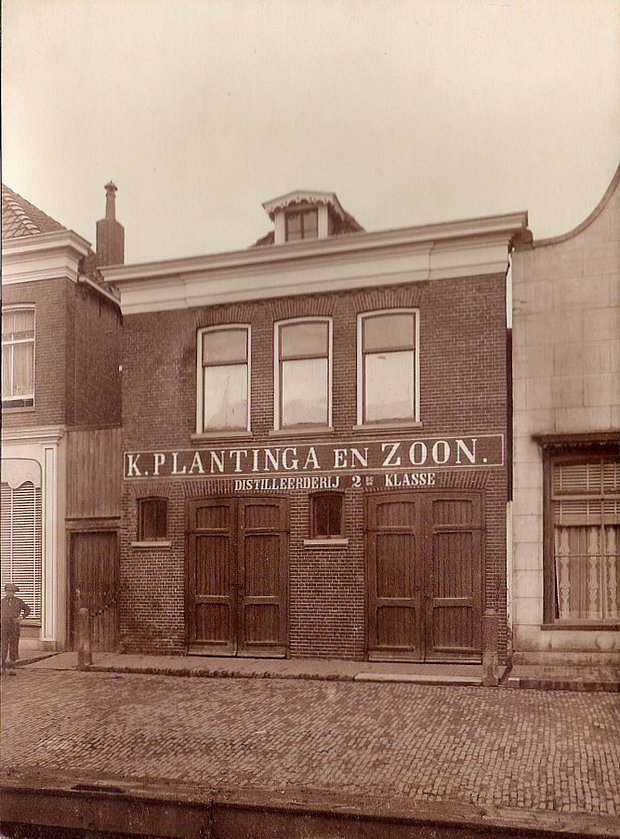In the early years, Plantinga primarily focused on his own type of so-called Beerenburg. It became especially popular in the Bolsward area, as it was considered a good cure against flu and the common cold. The typical and rather bitter taste is the result of Kalmoes (in English "Sweet Flag" or "Calamus", Latin Acorus calamus), which is not always present as much in other Beerenburg variations. Locally, this beverage became known as "a small KP" (Dutch "een KP-tje").
On 29 September 1900 his son Gerrit Herman (January 9, 1876 - November 30, 1962) joined Klaas Plantinga in the distillery. The company name then became "K. Plantinga & Zoon, Distilleerderij 2e Klasse" ("K. Plantinga & Son, distillery 2nd class"). The company type became VOF (Vennootschap onder Firma, sortof like "General Partnership"). On 8 October 1910 another of Klaas' sons, Sicco, joined. At that time Klaas himself retired. The company diversified into importing a variety of wines and spirits, as well as producing some themselves. Gerrit Herman's second son, Louwrens Baltus (October 5, 1902 - June 2, 1993) joined the company on 14 July 1920. He had studied in Berlin. He started sales outside of the Bolsward region. Louwrens Baltus, incidentally, is the man whose signature is on practically all Plantinga products, including Plantiac Vieux (though not, notably, on Plantinga Beerenburg).
Klaas Plantinga died on July 17, 1922. His wife, Ytje, had already died on March 3, 1922.
On 21 December 1933, the K. Plantinga en Zn. VOF became K. Plantinga en Zn NV (Naamloze Vennootschap, sort of like a "Joint-stock company"). Until World War II, the Dijkstraat shop was 'manned' by Ms Nettie van der Klei. She undertook sales, bookkeeping and general office work. When she married, her position was taken over by Piet de Boer, who was in turn replaced by Marten Katstra from Witmarsum when de Boer had to enlist. On 20 September 1941, Plantinga & Zn changed from "NV" to "CV" (Commanditaire Vennootschap, sort of like "limited partnership"). After the war, de Boer came back and the team was further enhanced by Jan van der Zee.
On 1 May 1955, the Plantinga company acquired the Louwrens Dijkstra winery in Leeuwarden. Dijkstra was Louwrens Baltus' grandfather from his mother's side. At this time, Plantinga logos and letterheads started displaying the "Leeuwarden" city name next to that of Bolsward.
In 1959, Louwrens Baltus Plantinga became seriously ill. His recovery lasted two years, during which family and personnel managed to keep the company afloat. From 1963 they had been helped by the Herman Jansen company (established in 1777), which ultimately took over entirely in 1965. At this time, the Plantingas lived at Stoombootkade 2. In 1967, the Herman Jansen company also acquired the Sonnema brand. Upon this happening, that company moved from Dokkum (also in Friesland) to Bolsward. And from 14 May of 1971 the various Plantinga/Sonnema-related activities took place at the new 1500-square-metre Stoombootkade 12 address. At that time, Plantiac was one of the major Dutch brands of "Vieux", and production took took place there.
In 1972, Herman Jansen merged with the Vlek company (from Delft) and was renamed UTO ("Unaniem Ter Overeenstemming", also "Unitas Tomet Optimum"). Plantiac production was moved from Bolsward to "De Tweelingh" distillery in Schiedam (also in the Netherlands, but no longer in Friesland).
On 30 November 1976 the Dijkstraat 7 shop got discontinued. In 2001, production of any remaining Plantinga-related products at the Stoombootkade 12 facility ceased when Plantinga Beerenburg was discontinued, thus making it a Sonnema-only facility.
In 2009 Plantinga Beerenburg rose from its ashes as Boalsert KP Beerenburg. In March 2011, the UTO company was renamed back to Herman Jansen.
